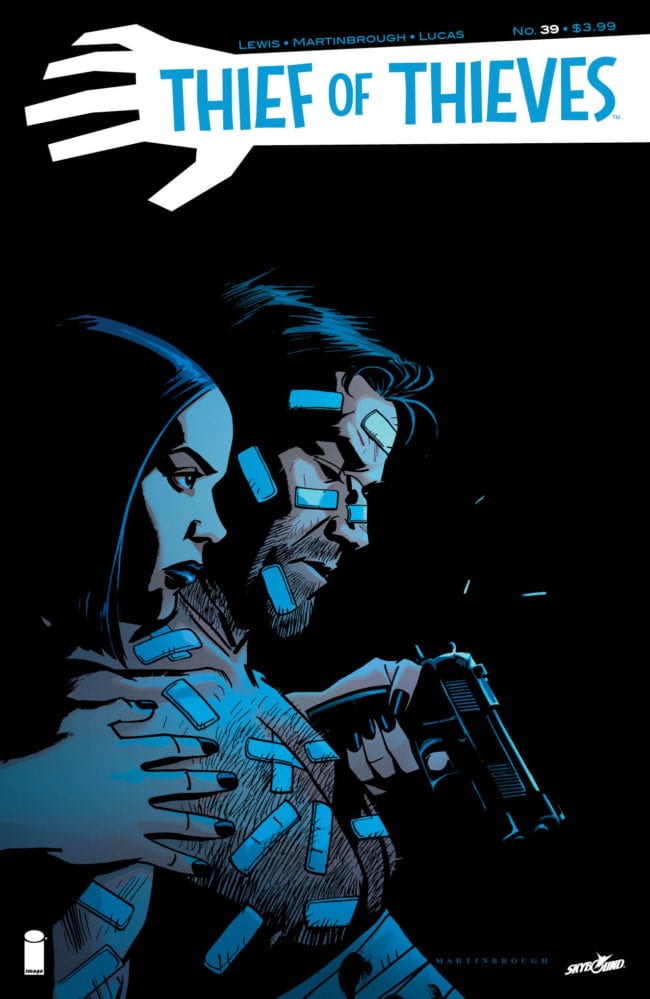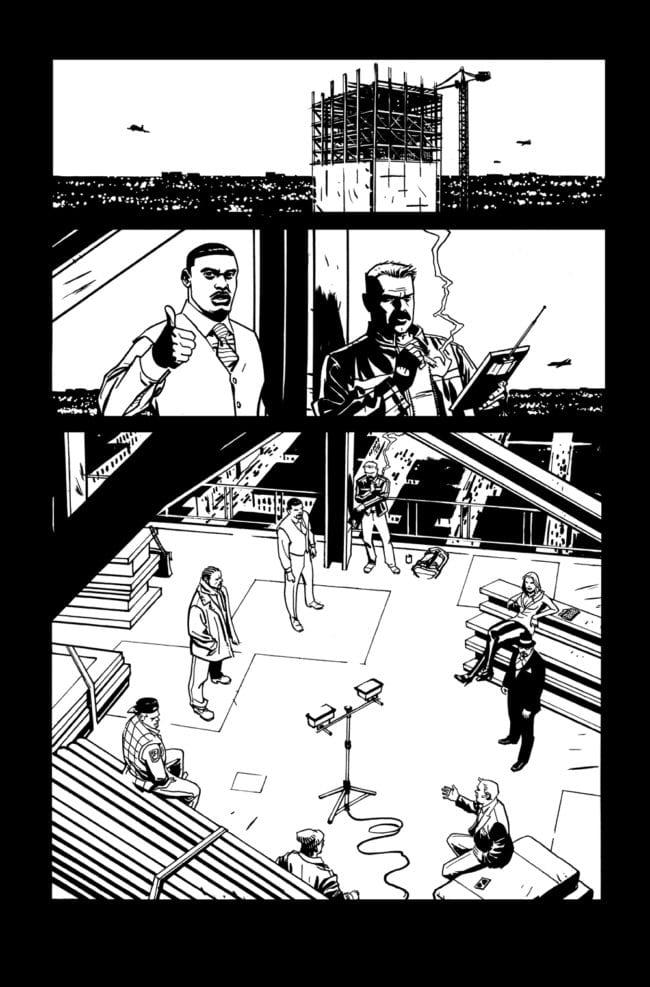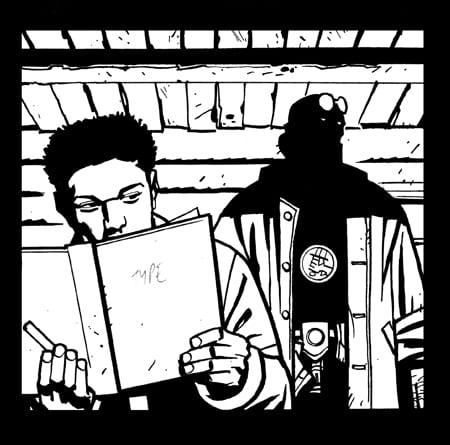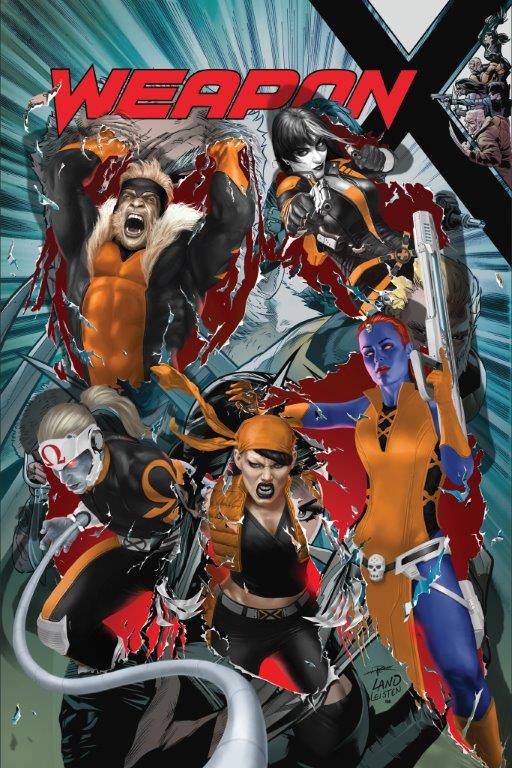
Shawn Martinbrough has been working in comics for more than a quarter century.
In the years since he’s drawn a number of comics including Angeltown, Luke Cage Noir, Hellboy, and he and Greg Rucka teamed up for a long run on Detective Comics. Martinbrough also wrote the book on noir in comics...or at least, he wrote a book on the subject, How to Draw Noir Comics: The Art and Technique of Visual Storytelling. The book laid out his thoughts on not just mood and style, but how to approach storytelling and design.
Martinbrough has been lecturing consistently over the past few years, not just at comics shows but schools and universities, the Pentagon, and last year he gave a talk at TEDxMidAtlantic in Washington, DC. He’s working with the George Lucas Museum of Narrative Art, which is being built in Los Angeles on their education programs for aspiring artists.
Right now he’s drawing the final issues of Thief of Thieves, the Image Comics series he co-created. In addition, his first gallery show, the career retrospective “Shawn Martinbrough: Storyteller” runs through July 21 at the Society of Illustrators in New York City.
 Thief of Thieves is not an artists driven series, the way we typically think of that, but it is atypical because it’s had a few writers but you’ve been the only artist on the series. What has this long run on the book been like?
Thief of Thieves is not an artists driven series, the way we typically think of that, but it is atypical because it’s had a few writers but you’ve been the only artist on the series. What has this long run on the book been like?
I've really enjoyed time illustrating Thief of Thieves. Kirkman and the entire Skybound editorial team over have been really supportive. From issue one, I’ve had complete creative freedom to do what I want visually with this series. During my career, I’ve been very fortunate to work with editors that don't micromanage and over the course of forty two issues, I can recall exactly two instances I've been asked to make artistic changes on Thief of Thieves.
When we spoke when the series launched, you said that one of the things that appealed to you was that you have total artistic freedom and you got to build it from the ground up.
It’s been great working with the all of the writers on the series. We started off with Robert Kirkman and Nick Spencer on the first arc. James Asmus wrote the second. Andy Diggle and I did three arcs together and now Brett Lewis is onboard to finish up the series with this last arc. All along the way, everyone has been in total sync. Each writer gets my storytelling approach and for me it’s all about visualizing the script to the best of my ability. As the artist, my job is to expand on what the writer puts down on a page. From a visual standpoint, it’s been a fun ride developing this story, the characters and helping to build this world from the ground up
This is the longest run you’ve ever had on a book. What has that been like?
Looking at the vast array of characters that we’ve introduced, one of the things I’m very proud of with this series, is how distinct and varied the characters are. Coming from so many different walks of life, each character has their own style and specific, visual "tic". Over the forty issues and multiple arcs of the series, there are such a myriad of different character type in this series. Whenever I get a new script the challenge is, how can I draw this better than the last issue. Part of my drawing process is that I have two bulletin boards on my studio wall. I put up finished pages as I draw so I’m always looking at them to maintain continuity throughout the issues.
You’ve said that you always think of your work as finished when you finish with them, even though they’re going to be colored. Do you still think that way?
That’s still my approach. As a graduate of the School of Visual Arts, I paint and understand color theory. However, since I’ve been working in black and white for so many years, a weird thing has occurred where I can’t color my own artwork. I can only see it in black and white. Our colorist Adriano Lucas is fantastic and has been with the series for about thirty issues. We work very closely to design the color palates and approaches to different scenes. Even though I see the pages as black and white, I'm okay with letting go and seeing the art translated into color. It would be cool to see Thief of Thieves printed in black and white at some point in the future.
So you want to work with a colorist the way you work with a writer? You may talk but you each have your jobs and respect and don’t step on each other’s toes.
My dynamic with the writer is a bit different. I never give the writers notes, but there have been times when I come to a point in the script where I need to alter something because it will make the storytelling better. That’s the extent of my edits. I have good relationships with writers so they trust that I know what I’m doing and whatever changes I might make will make the storytelling better. I’ll never arbitrarily omit something from script because that’s disrespectful to the writer, but I might condense or simplify a point of action. That doesn’t really require back and forth with the writer whereas with Adriano, he will send me colored pages as a heads up. I'll give feedback and ask if we could tweak this here, push more there or can we try a different approach all together.
 What’s kept you interested with Thief of Thieves all this time?
What’s kept you interested with Thief of Thieves all this time?
It’s a fun series and as a fan, I'm curious to see where this story will go next. Who are the new cast of characters that are going to be in the next story arc? How will this end? I’m invested in these characters and have a real connection to Conrad, Celia and the rest of the cast of Thief of Thieves. However, all stories need an end point and I suppose there’s a certain feeling of ownership that I have with the series. I started the journey with these characters so it feels right to see them to the finale.
Right now you have show at the Society of Illustrators. How did that happen?
I’ve spoken about my art and process at the Society of Illustrators prior. Annelle Miller is the director and she invited me to create an exhibit. I’m a native New Yorker and was exposed to the Society way back in high school. I attended a cartooning class headed by artist Michael Davis. He took the class on a field trip to the Society and it was such a cool place. They would put out annuals collecting great art by contemporary artists. The annuals were around fifty bucks a pop and I was a student so I couldn’t afford to buy them brand new. So I would go to the Strand Used Book store in the Village and buy the annuals used for cheap. I still have those annuals. Fast forward thirty years, it’s very trippy to have a show there and to follow the artist, Mike Mignola is really mind blowing. Mike is one of my biggest influences in terms of contemporary artists. Working with Mike on Hellboy and The B.P.R.D: Secret Nature and to have my show follow his at the Society is crazy.
So when they asked – and you said yes, because who says no to that? – what’s the process of putting together a show like this?
We had agreed to do the show last year. I put it to the back of my mind and then they reached out to me in March and said, “So, we’re going to need your artwork soon.” I’ve always had fears of putting artwork in a shipping box so I delivered the art personally. I asked, how many pieces were the Society envisioned for the show. They said forty to fifty. I went to my studio closet, where I keep all of my original artwork and started going through it. After the first round, I had a pile of more than one hundred pieces. I cut that down considerably, then finally gave up and left it up to the Society to make the final selections. I just asked for a nice cross section of past projects. I included mainstream illustration work I’d done for commercial clients and sequential pages from Detective Comics, Luke Cage Noir, Black Panther: Man Without Fear and of course, Thief of Thieves. It was nice seeing their positive response to the original pieces.

So you keep most of your original art?
I keep all of my original artwork. I was inspired by comic book industry veteran, Walt Simonson who holds on to all of his original art. I always blame him for this. I thought it was a smart idea to sit on my artwork. The larger my body of work, hopefully, the more the originals would be worth. So currently, I don’t sell any of my original art.
What was it like when you actually walked through the exhibit?
I so pleased with the job the Society has done on my exhibit. They've grouped sequential pages of artwork so it flows extremely well. Viewers can follow a scene (or several scenes) from page to page as they walk through the show.
Seeing pages in isolation on the wall at a show is a very different from seeing them printed in a book.
Preparing for this exhibit has created an opportunity for me to appreciate my past work. Too often as artists, we turn the art around, move onto the next project and it piles up in a drawer somewhere. For me, this is a really good opportunity to stop and actually appreciate the work that I’ve done. I’m usually my biggest critic so I always see the flaws. The many ways I could have done something better. It was a nice chance way to just absorb the work and appreciate how others react to it.
An interesting example of seeing art in person versus in print was seeing Mignola’s show. I was really surprised how grey the original art was. His work prints as stark black and white but the originals were complete gray washes. It creates a completely different effect seeing it in person. It’s funny because I’m always searching for THE black ink that will create the richest, deepest blacks. It was such a stark contrast seeing Mike’s work which was almost completely gray and my work which was stark black. The Society folks were like, “How did you get your blacks so black?” and I'm never satisfied that the ink is dark enough. It’s a different experience seeing original art in person.
You said you’re your own worst critic. Going through all those pages to prepare this exhibit, what jumped out at you about your work?
I can definitely see progression in my work over the years, which is what I’ve strived for. Despite being insanely critical, I can still appreciate my older work. With Morlocks art on display in particular, I still happy with the line work. It’s a really good balance between really crisp sharp lines and heavy bold strokes. A lot of that art is far looser than my current work and I’m not necessarily mad at that. Also, it was really interesting to see the storytelling choices that I made back in the day. Looking at some old Detective Comics work I thought, that wasn’t a bad approach to telling the story in that panel.
One of the projects you did last year was Hellboy & The B.P.R.D.: Secret Nature.
That was really exciting on a number of different fronts. First off, like I said, I’m a huge Mike Mignola fan. He and writer Chris Robeson came up with an interesting, fun but socially relevant story. The biggest challenge was going from the world of Thief of Thieves, which is so grounded and realistic, to embracing the fantastical world of Hellboy. I really have to credit former Dark Horse editor, Scott Allie for helping me with that. Scott encouraged me to let loose, embrace this fantastical world and to get into the groove of drawing Hellboy. Who is not an easy character to draw. Once I found my approach, it was fun just to focus on telling the story in the most interesting way possible.
Hellboy is a lot harder to draw than he looks. And stylistically you seem a good match for drawing Hellboy, but in other ways, it’s very out of your wheelhouse.
Hellboy is deceptively simple looking. It was interesting to actually study the angles of his space and how his form is constructed. That really helped me. I always try to put in interesting human details about how a character stands and interacts when I draw a them. In one of the early scenes, as he listens to a farmer explaining why he called them to investigate, I drew Hellboy scratching his chin. Small details like that are elements that I bring to any project that I’m working on. Trying to find those little, average human moments in any story that I draw is what really drives me as an artist.
It can be a character simply scratching their chin or flicking dust off their shoulder during a conversation. Those details are what I try to capture in every story that I draw.
Before I started drawing, I looked at other artists who have drawn the series just to find a rhythm. Obviously, I was familiar with all of the Mignola stuff and there have been many great artists who have done great work on the series but after Mike, Duncan Fegredo had my favorite take on Hellboy.
 Back to readers noticing the little details. When DC Comics collected Mignola's Cosmic Odyssey mini series last year, I posted about it because I was so excited. Mike Mignola chimed in on my post. I said, okay, now that I have you on the hook, I have a bunch of questions to ask you about this project. These are questions that have been burning in the back of my head for years. For example, there’s a scene where a guy is painting one of the doomsday devices yellow – who is that guy? That image has been burned into my psyche for years. It’s a small inconsequential detail, but what was the deal with that? Mike answered the question and it was hilarious that we’re having this conversation. That's the power of art, there’ll be this one little detail that you pick up on and it just sticks with you.
Back to readers noticing the little details. When DC Comics collected Mignola's Cosmic Odyssey mini series last year, I posted about it because I was so excited. Mike Mignola chimed in on my post. I said, okay, now that I have you on the hook, I have a bunch of questions to ask you about this project. These are questions that have been burning in the back of my head for years. For example, there’s a scene where a guy is painting one of the doomsday devices yellow – who is that guy? That image has been burned into my psyche for years. It’s a small inconsequential detail, but what was the deal with that? Mike answered the question and it was hilarious that we’re having this conversation. That's the power of art, there’ll be this one little detail that you pick up on and it just sticks with you.
In the past couple years you’ve done a TED Talk, you did events at the Pentagon and elsewhere. How did you get started doing that and what has it been like?
I frequently receive invitations to speak at colleges and other institutions. Typically, the way it works is, someone will see you on a panel and then they’ll invite you to speak at their event or company. It becomes a domino effect. With regard to my The TED Talk, a friend at Lockheed Martin shared that the TED folks were organizing a talk here in DC. It had a superhero theme and would I be interested in an introduction. I had conference call with the director, we hit it off and I did the talk. The DC metro area is a very military heavy town. Colonel Eries L.G. Mentzer, a National Defense Fellow at the Woodrow Wilson Center for Scholars was in the audience. She was inspired by my talk and invited me to speak to some Air Force officers at the Pentagon.
The nice thing about these talks and giving lectures in general is that, they give others some insight into the life of an artist. Aspiring artists especially, are impacted by these types of talks and exchanges. I know first hand, when I met artists in my early years, it was a big deal. These interactions can be so important to people. Any opportunity that I have to share my experiences of becoming a professional artist with anyone, I'm happy to do so.
As you’re finishing Thief of Thieves, have you started thinking about what you want to do next or what you want to focus on more?
I definitely want to do more writing. I’ve been writing for some time now. Years back, I wrote and directed a series of short films that ran in a number of film festivals. It would great to direct again. Some of the greatest experiences of my life have been working with actors and directing on location in New York City. I also have a number of creator owned projects that I plan to write as well as draw. There are some projects that I’ve been developing with publishers and media companies that I’m planning to announce in the next few months and also keeping my options open. Many writer friends, whose work I love, say to me, “We’ve got to do something!” I would love to. It’s just a matter of finding the time to squeeze everything in. I'll continue to lecture and have several speaking engagements lined up. I’m very excited to be working with the George Lucas Museum of Narrative Art on a Los Angeles based art program for aspiring artists and storytellers. We’ve been planning about this for months and the project works in conjunction with the new art museum due to be completed around 2021.
You and Joe Illidge were writing a graphic novel together a few years back. Whatever happened to that?
You're referring to The Ren. That was a book that we co-wrote for First Second books. Things happened. It fell into limbo. Currently, we’re looking for a new artist to join the project. The folks at First Second have approached a few talented artists so we’ll see what happens. Mentally, I put it on the back burner but hopefully that project will get back on track. It's a wonderful American story that deserves to be told.
You’ve made some short films like you said, you want to direct more?
I definitely think directing is a natural progression for my career. As an artist on a graphic novel series, you are essentially, the director. You’re also the cinematographer, casting director, location scout, costume designer, gaffer, craft services, etc. It’s very organic to go from telling a story sequentially panel to panel to making the jump to telling a story frame by frame. I would love to get behind the camera again and shoot something. I was directing back before digital really stepped up its game in terms of quality. Nowadays you can really shoot a professional looking piece of storytelling with a camera phone. Again, it's simply a matter of making the time to direct again...in the near future.
Maybe a book printed in black and white?
I would love that. It’s interesting because stories told in black and white are appreciated overseas far more than here. It’s just a matter of finding the right home for the right project.
I also feel like your name keeps popping up in the credits of shows and movies for all these characters you have co-created and drew where they weren’t huge and the book didn’t last that long, but that have lasted and made an impact.
It’s a testament to comics. The same way I remembered that detail in Cosmic Odyssey, somebody somewhere saw a comic book and said, that’s a really cool character. There should have more done with that character. If that person happens to be an executive or someone with some kind of clout or power, they can make it happen. It’s a very interesting time to be a comic creator.
In my experience artists either remember those panels or pages like they just drew them, or they go, “when was that? Did I draw that book?”
That’s true. People have asked me specific questions about past work and my reaction is, “What the hell are you talking about?” [laughs]. I always get flashbacks when convention fans bring books to me to sign and I’m like, I totally forgot about that. However to them, it’s fresh in their minds and they love it. I’m like, “You liked that? Really?” But you can’t pooh-pooh someone’s fond reaction to something you've created but might despise. It’s fascinating anytime you have that kind of interaction with fans. It's all part of the comic book experience.






